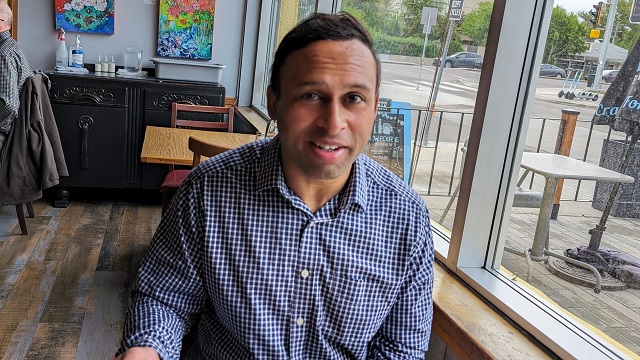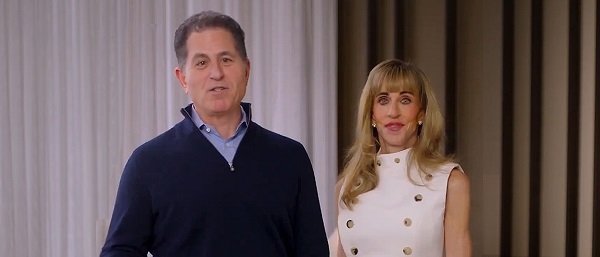Addictions
Alberta and opioids III: You can’t always just stop

Monty Ghosh at Highlevel Diner, May 30. Photo: Paul Wells
By Paul Wells

This is the concluding installment in a series on drugs in Alberta. Previously:
i. “Worse Than I’ve Ever Seen,” June 4
ii. “Alberta’s System Builder,” June 7
To support ambitious reporting on important issues, please consider a paid subscription:
A matter of expectations
Street family
My tour guide for much of my visit to Edmonton was Dr. Monty Ghosh, a clinician who’s on faculty at the University of Calgary and the University of Edmonton. He seems to talk to everybody who works with substance users in Alberta, from his own patients to front-line clinicians to the Alberta government. His relations with the latter go up and down, but he urged me to talk to Marshall Smith, the chief of staff to premier Danielle Smith.
On my first night in Edmonton Ghosh walked me around a neighbourhood that included the George Spady Society supervised-consumption site, the Hope Mission’s Herb Jamieson Centre, and the Royal Alexandra Hospital, which has a supervised-consumption service on its premises.
A lot of people use the services these places provide. Other people don’t. Shelters in particular are tricky: they’re usually for single people who arrive alone. “The Hope, the Herb, the Navigation Centre, offering the world,” one Edmonton Police Service officer told me. “But all these places have one thing in common: rules.” If you have a spouse or a pet, you want to keep your drug supply or you want to stay close to your “street family” — the community spirit in neighbourhoods like this is striking, and might be surprising to people who prefer to stay away — a shelter’s probably not for you.
Several of the places we visited weren’t ready to welcome us when we showed up unannounced. To say the least, they’re busy. That was the case at Radius Community Health and Healing, an institutional building in a more residential part of the neighbourhood. Radius is a drop-in clinic and, as we’ll see, quite a bit more.
On a sunny weekday afternoon, more than a dozen people stood, sat or lay on the building’s front steps and truncated lawn. One lay on his back, shirtless, not moving visibly. Ghosh asked the man whether he was all right, asked again, finally nudged him. The man stirred, looked around. Ghosh apologized mildly for bothering him, then checked in on two other people who also weren’t moving. They turned out to be all right too.
Francesco Mosaico, Radius’s medical director, was on his way home for the day when we arrived, but we made plans to talk the next day. When I returned, I met Mosaico and Radius’s executive director, Tricia Smith, in her office.
I think it’s important to hear them out, because when drug use becomes the object of political debate, it’s natural to talk as though policy decisions are the main thing keeping people from getting well. This can lead to a lot of blame on one hand, and to excessive optimism on the other. In fact the biggest thing that keeps people from getting well is often the entire sum of their lives until now, compounded by the influence of drugs that are more potent than anything earlier generations had to deal with.
The most complex patients
Radius offers primary care to people “experiencing multiple barriers,” Smith said. That can include homelessness, addiction, severe mental health problems, criminal records. The centre’s team includes 12 family physicians and three psychiatrists. They currently see about 3,000 patients.
Radius has Western Canada’s only non-profit dental clinic. The centre runs a respite program for people who are not sick enough to be in acute care but are too sick to be managing independently on their own. It has a program for pregnant women experiencing homelessness. It runs on a harm-reduction model, so they don’t need to be drug-free to go into the program. It has an interdisciplinary Assertive Community Treatment team to help people with mental-health and substance problems find and stay in market apartments, with frequent assistance. There’s a supervised consumption site in the basement.
“In fact,” Smith said, “we actually have an exemption from the College of Physicians and Surgeons of Alberta to filter out and keep the most complex patients. The least complex, we refer elsewhere.” I couldn’t get care in Radius if I tried; they’d politely refer me elsewhere. They’re for the people who need the most help.
After my visit, Smith wrote to me to add another program to the list: Kindred House, which for more than 25 yearss has supported women and Trans women sex workers. “The women we see are from age 18 to 50, predominantly Indigenous, have intergenerational trauma, past/current trauma, substance use issues, often houseless or couch surfing,” Smith wrote.
Smith has been at Radius for three and a half years. While I was there, I asked her how work at Radius is going. “It’s going fabulously, honestly,” she said. She arrived early in the COVID pandemic, after eight years in Alberta government departments — which in turn followed 20 years as a Canadian Forces army nurse, including in combat zones. “I’m in the right place,” she said of Radius. “It felt like coming home.”
How come? “The staff, the team, the work, the dedication. It just feels like family. I missed that. Being in the military was a big thing. This work that this group does is just really amazing. The team is amazing and it’s hard, but it’s good work.”
And how’s the workload evolving? “Unfortunately, for this population, the struggles are only increasing, and the number of individuals that are experiencing those challenges is not getting less,” she said. “The workload isn’t going anywhere. It’s getting more difficult.”
Paul Wells is a reader-supported publication. To receive new posts and support my work, consider becoming a free or paid subscriber.
“Especially in the last couple years, I don’t think things have ever been worse for the vulnerable population,” Mosaico, Radius’s medical director, added. The same housing crunch that has made homes less affordable for everyone has put thousands of the most vulnerable on the street. Results: more frequent frostbite or burns from lamps lit to keep from freezing. Body lice. Trauma from watching friends die. And to Mosaico’s astonishment, frequent shigella outbreaks.
“Shigella’s a bacteria that causes torrential bloody diarrhea. It can be treated with a single dose of antibiotics. But if you’re homeless and you don’t have a place to take care of yourself… 70 percent of the cases have had to be hospitalized in the last two years…. I mean, they’re talking about potentially calling it an endemic disease, and it’s a disease of destitution. You see it in refugee camps in developing countries, not in the capital of Alberta, you know?”
Ten thousand times deadlier
Radius also works closely with the Alberta government to integrate its services with the “recovery-oriented system of care” that I told you about last week. There are two Radius staffers working at the Integrated Care Centre the police set up to replace the old, passive holding cells for overnight detention. There are two more at the Navigation Centre, which steers people toward social and government services. If there’s an Alberta model, they’re part of it. So I was fascinated by the response when I asked my hosts the basic question that sent me to Alberta: Why are so many people dying?
“I think it’s the nature of the drugs,” Mosaico said. “You know, people used to overdose and die. But I’ve been here 17 years. I think in the first 10 or 11 years it wasn’t very common to hear about overdoses by opioids. Every once in a while you’d hear about it, but it wasn’t a daily thing. Whereas now with fentanyl and carfentanil, it’s really dangerous.”
Carfentanil is 10,000 times more potent than morphine, 100 times more than fentanyl. The Edmonton Police won’t return stolen cars they recover until they’ve scrubbed them thoroughly, because even trace amounts of these drugs are too dangerous. “We’re finding clients who use methamphetamines and swear up and down they’re not taking opioids,” Mosaico said. “And then we do urine tests and it’s there. We think their dealers are lacing methamphetamine with fentanyl because it increases the addiction.”
The other big thing on his mind, Mosaico said, is that any program to guide users into recovery will bump up against the fact that different people have often lived starkly different lives.
93% 4+
“I don’t know if you’re familiar with Adverse Childhood Experiences — the ACEs study,” Mosaico said. I was, barely, but I needed a refresher.
The original study began in 1985 in San Diego, under Vincent Felitti, who ran an obesity clinic, and Rob Anda from the Centres for Disease Control. (If you want to learn more about the study, this article and this speech on Youtube are good places to start.)
“They surveyed 17,000 people,” Mosaico said. “They found, you know, if people had developmental trauma — so, trauma between the ages of 0 and 18 — and there are 10 different forms of trauma that the study bore out as being detrimental. Things like physical, emotional, sexual abuse; physical, emotional neglect; substance use in the family; untreated mental illness in the family; separation from biological parents; maternal figure being treated violently; and a household member going to jail.
“If those things occurred, you would just tally up the number of types of trauma and you’d get a score out of 10. What they found was, if you scored four or greater, that there seem to be adverse health effects in adulthood. And it wasn’t just the presence of addictions or mental illness. It was lung disease, heart disease, liver disease, certain forms of cancer, diabetes, obesity.” This is almost folk wisdom today, but at the time, Felitti and Anda were amazed at the strength of the correlations between childhood trauma and adult physical and mental health.
The original test has been widely replicated, and it usually finds that the proportion of people in a sample who’ve had four or more adverse childhood experiences is about 12%. So something like every eighth person you meet had a really difficult childhood, and while you can’t predict for individuals from statistical trends, there’s a good chance they’re still living with the fallout.
The team at Radius surveyed a large sample of the population under their care. The prevalence of high-risk ACE scores was about 93 percent, compared to 12 in the general population,” Mosaico said.
“Harvard has a center on the developing child, which has pulled together a lot of the science that explains the neurobiological link between the adverse trauma and the adverse health effects. They talk about limitations in the development of executive function, of decision-making, emotional regulation. Impulse control is underdeveloped, neuroanatomically in the brain. And instead what over-develops is the fight-or-flight response.
“So you’re dealing with a population that, because of their experiences, isn’t the same as the general population . And then that’s compounded by the fact that a high percentage of those clients who have high ACE scores also have traumatic brain injuries from living rough on the street. They also have adult trauma that compounds the childhood trauma. They have [fetal alcohol spectrum disorder], which impairs executive function even further.
“I hear these success stories and I think they’re wonderful, when you hear about people who have a difficult life and then they straighten up. And then, you know, they go back to their jobs and their families and they become leaders in their communities. But this is a population which is over-represented in every aspect of society, negatively as it were. In the prisons and child family welfare services. In the health system, you know, prevalence of HIV, tuberculosis, Hepatitis C, STIs, all that.
“And you look at them and you think, even if they managed to wait, you know, six months to get into an addiction recovery bed, after waiting for weeks to get into detox and they go through the program, what do they go back to? Most of them had to drop out of school. They have criminal records, which makes it hard to get a job. They’re disconnected and estranged from their families. They haven’t learned social skills.
“I had a client who lived in dumpsters for two and a half years. The fact that he just stayed housed — on income support — for the rest of his life was a huge win, right? It was important for his dignity, his quality of life. It’s just a matter of adjusting your expectations of what might actually be realistic.”
Thank you for reading Paul Wells. This post is public so feel free to share it.
Dr. Larson writes
The idea for these stories goes back to February, when it first became clear to me that 2023 would be Alberta’s worst year for overdose fatalities. I asked the communications team at the University of Calgary for names of people to talk to. Many weeks went by, because sometimes it’s ridiculous how hard it is to extract myself from Ottawa routine. After I published the second article in this series, the one where Marshall Smith showed me all the stuff Alberta is building, I received an email from Dr. Bonnie R. Larson, who’s on faculty at the University of Calgary. She thought I should have talked to her, and she thought I was too credulous in reporting the Alberta government’s side. I asked if I could publish part of her email. Here it is.
What cannot be taken for granted is Mr. Smith’s view that his goals are different, somehow nobler, than those of us on the front line. Smith paints a picture that front line providers’ priorities are at odds with his own. His perspective is at once undemocratic, insulting, and arrogant, belittling those who are doing the hard work of keeping people alive every day.
I will not have Smith speak for me in his suggestion that front liners lack system knowledge and that is why we support harm reduction. This ignores the excellent evidence supporting harm reduction interventions at the population level. Smith seems to think he knows from whence I “enter this conversation”. If so, why does he not engage me and my expert colleagues? Where I “enter this conversation” is at 20 years of working with the affected community and 13 years of post-secondary education. The only reason I am what Smith likes to dismiss as a “radical harm reduction activist”, is because the UCP, immediately upon taking office, set out to destroy harm reduction in Alberta. Nobody would have ever needed to fight this soul-destroying battle in the first place if Smith hadn’t put Alberta squarely on its current path of destruction. Yes, we should hope for a better tomorrow but that doesn’t excuse ignoring the past and present.
I would ask you to think about several additional factors that your analysis appears to ignore, including who actually benefits, in power and wealth, from Smiths’ system of so-called care? DId you consider the other ways that the UCP policy direction is moving the entire publicly-funded system steadily towards profit? Gunn (McCullough Centre) was a wonderful non-profit facility that helped many of my patients find their way to recovery from substance use disorders. While I agree that people should not have to pay for treatment, the question remains: in whose pockets do those tax dollars ultimately land?
You report that Smith indicates that they are “monitoring” the entire system. Where is the data from that monitoring? They have had five years now to show some outcomes, but who am I, just a lowly street doctor, to ask for population data? What I do know is that if deaths begin to decline, it is because so many are already gone. You should ask to see the data about which Smith so proudly boasts.
Smith’s entire premise that he is fixing the ‘addiction crisis’ is a fallacy. Addictions are not increasing. Deaths by drug poisonings are, however, and Smith’s circus is only making that worse. Allow me to spell it out for you: harm reduction addresses the drug poisoning crisis that is, no question, taking a horrific toll in Alberta and nationally. Smith’s ROSC, in contrast, addresses a figmentary addictions crisis.
One last tip. Medications used for opioid agonist treatment are not harm reduction, they are treatment. Nobody here is against treatment or recovery. But Marshall Smith is against harm reduction. Why can’t we just have the full spectrum of care??? Polarization is created by politicians to benefit politicians.
I don’t endorse everything Dr. Larson writes here. The data, or a lot of it, seems to me to be publicly available on the province’s impressive dashboard website. Use the tabs at the top of the page to navigate. And indeed, the story the dashboard tells is alarming, which, as I explained in this series’ first instalment, is why I flew west. But Larson’s years of front-line work has earned her, at the very least, a right of rebuttal.
Synthesis
On my last day in Edmonton, I met Monty Ghosh at Highlevel Diner, at the outer edge of the hip Strathcona neighbourhood on the south of the North Saskatchewan River. Highlevel is famous for its cinnamon buns, which, if I’m going to be honest, are noteworthy mostly for being large.
If the Alberta government and its most vociferous critics are thesis and antithesis, Ghosh tries to provide synthesis. He helped design the National Overdose Response Service, or NORS, which provides some of the emergency-response capability supervised consumption sites offer to people who aren’t near such a site or can’t use it for other reasons. He’s been critical of the Alberta government, but both sides keep lines of communication open.
I asked him about diverted safe supply — the idea that pharmaceutical opioids used in safe-supply programs in BC, principally hydromorphone tablets, are being sold or distributed away from their intended use. “I know it happens,” Ghosh said. “We sometimes get clients from British Columbia who come to Alberta to try to escape BC, because they’re looking for a fresh start. They’re looking for support and they’ll tell me themselves that they’ve diverted their safe supply.”
But what are the quantities? Trivial so far, Ghosh maintains. “Have I seen hydromorphone come into our province? Not at all, not yet.” This is the same thing I heard from Warren Driechel, the Edmonton deputy police chief.
Why do people divert their prescribed safe supply anyway? The answer Ghosh gave me was the answer I heard from everyone I asked. “They never used it. It just was not effective. The potency of the hydromorphone that they’re getting was nowhere near touching the fentanyl that they were using. It wasn’t dealing with the cravings, it wasn’t dealing with withdrawals, they felt it was useless. So what did they do? They sold it. They’re incredibly poor, they cannot afford their substance-use concerns and so therefore they supplement with revenue from hydromorphone.”
Before I flew to Edmonton, when Ghosh and I were trying to gauge on the phone what each of us thought of this infernal crisis, he figured out that I was interested in the differences between government policy in British Columbia and Alberta. “I’m not sure you want to hear this,” he said, “but I think it’s going to be bad everywhere.” I said that’s what I think too. Perhaps I surprised him.
I don’t know what happens next. Maybe things just stop getting worse everywhere on their own, for big complex reasons that resist easy analysis. Overdose deaths were lower last year in the United States, the capital of this hellscape, than the year before.
If not… well, we shall see. I wonder what happens in year six or seven of the effort the Alberta government is building. Is there resentment among people in ordinary hospitals and correctional facilities, who don’t have access to bespoke programs and personal attention? Does the ROSC system become bureaucratized after the first generation of administrators moves on?
Or does it start to win converts? David Eby, the NDP premier of British Columbia, has started putting distance between himself and his public-health advisors on legalization and safe supply. A new appointment in BC is being closely watched in Edmonton.
Or, conversely, does the Alberta recovery effort bump up against the limits imposed by the substances involved and by human nature? Reported recovery rates from addiction vary widely, depending in part on how you measure them. This paper puts the rate at less than 30%. If you even manage to double it, that still leaves a large cohort who aren’t getting better. Would their neighbours see them as people who “failed recovery” or “blew their chance?”
I won’t claim to know. I do hope that in the year ahead, more Canadians check their assumptions and stow their cheap certainties. Especially those who aspire to positions of leadership.
For the full experience subscribe to Paul Wells.
Addictions
Manitoba Is Doubling Down On A Failed Drug Policy

From the Frontier Centre for Public Policy
Manitoba is choosing to expand the same drug policy model that other provinces are abandoning, policies that normalize addiction while sidelining treatment, recovery, and public safety.
The New Democrat premier of British Columbia, David Eby, stood before reporters last spring and called his government’s decision to permit public drug use in certain spaces a failure.
The policy was part of the broader “harm reduction” strategy meant to address overdose deaths. Instead, it had stirred public anger, increased street disorder and had helped neither users nor the communities that host them. “We do not accept street disorder that makes communities feel unsafe,” Eby said. The province scrapped the plan.
In Alberta, the Conservative government began shutting down safer-supply prescribing due to concerns about drug diversion and misuse. The belief that more opioids can resolve the opioid crisis is losing credibility.
Ontario Progressive Conservatives are moving away from harm reduction by shutting down supervised consumption sites near schools and limiting safer-supply prescribing. Federal funding for programs is decreasing, and the province is shifting its focus to treatment models, even though not all sites are yet closed.
Yet amid these non-partisan reversals, Manitoba’s government has announced its intention to open a supervised drug-use site in Winnipeg. Premier Wab Kinew said, “We have too many Manitobans dying from overdose.” True. But it does not follow that repeating failed approaches will yield different results.
Reversing these failed policies is not a rejection of compassion. It is a recognition that good intentions do not produce good outcomes. Vancouver and Toronto have hosted supervised drug-use sites for years. The death toll keeps rising. Drug deaths in British Columbia topped 2,500 in 2023, even with the most expansive harm reduction infrastructure in the country. A peer-reviewed study published this year found that hospitalizations from opioid poisoning rose after B.C.’s safer-supply policy was implemented. Emergency department visits increased by more than three cases per 100,000 population, with no corresponding drop in fatal overdoses.
And the problem persists day to day. Paramedics in B.C. responded to nearly 4,000 overdose calls in July 2024 alone. The monthly call volume has exceeded 3,000 almost every month this year. These are signs of crisis management without a path to recovery.
There are consequences beyond public health. These policies change the character of neighbourhoods. Businesses suffer. Residents feel unsafe. And most tragically, the person using drugs is offered little more than a cot, a nurse and a quiet signal to continue. Real help, like treatment, housing and purpose, remains out of reach.
Somewhere along the way, bureaucracies stopped asking what recovery looks like. They have settled for managing human decline. They call it compassion. But it is really surrender, wrapped in medical language.
Harm reduction had its time. It made sense when it first emerged, during the AIDS crisis, when dirty needles spread HIV. Back then, the goal was to stop a deadly virus. Today, that purpose has been lost.
When policy drifts into ideology, reality becomes an afterthought. Underneath today’s approach is the belief that drug use is inevitable, that people cannot change, that liberty means letting others fade away quietly. These ideas do not reflect science. They do not reflect hope. They reflect despair. They reflect a politics that prioritizes the appearance of compassion over effectiveness.
What Manitoba needs is treatment access that meets the scale of the problem. That means detox beds, recovery homes and long-term care focused on restoring lives. These may not generate the desired headlines, but they work. They are demanding. They are slow. And they offer respect to the person behind the addiction.
There are no shortcuts. No policy will undo decades of pain overnight. But a policy that keeps people stuck using is not mercy. It is maintenance with no way out.
A government that believes in its people should not copy failure.
Marco Navarro-Genie is vice-president of research at the Frontier Centre for Public Policy and co-author, with Barry Cooper, of Canada’s COVID: The Story of a Pandemic Moral Panic (2023).
Addictions
The Death We Manage, the Life We Forget

 Marco Navarro-Génie
Marco Navarro-Génie
Our culture has lost the plot about what it means to live.
Reading that Manitoba is bringing supervised consumption to Winnipeg got me thinking.
Walk through just about any major Canadian city, and you will see them. Figures bent forward at seemingly impossible angles, swaying in the characteristic “fentanyl fold,” suspended between consciousness and oblivion. They resemble the zombies of fiction: bodies that move through space without agency, awareness, or connection to the world around them. We think of zombies as the walking dead. Health workers and bureaucrats reverse their overdoses, send them back to the street, and call it saving lives.
At the same time, Canada offers medical assistance in dying to a woman who cited chemical sensitivities and the inability to find housing. It has been offered to veterans who asked for support and were met instead with an option for death. We fight to prevent one form of death while facilitating another. The contradiction is not accidental. It reveals something about the people involved and the funding behind it. That’s our culture. Us. It appears to me that our culture no longer knows what life is.
Ask any politician or program bureaucrat, and you will hear them explain, in the dry language of bureaucracy, that the twin approach to what they call harm reduction and medical assistance in dying (MAiD) rests on the shared premise of what they believe to be compassion. They think they respect autonomy, prevent suffering, and keep people alive when possible. It sounds humane. It is, in practice, incoherent. Bear with me for a moment.
The medical establishment administers naloxone to reverse overdoses in people who spend as many as twenty hours a day unconscious. They live without meaningful relationships or memories, with little capacity for choice. The technocrats and politicians call that saving lives. They also provide assisted death to people whose suffering comes primarily from poverty, isolation, or lack of housing. There was a time when these factors could, at least in theory, be addressed so that the terminal decision did not need to be made. Now they are accepted as grounds for ending life.
But why is one preference final and the other treated as an error to correct? That question reflects the deeper disorientation.
We saw the same thing during COVID. Elderly people in care homes were left without touch, family, or comfort for days. They often died in solitude, their dementia accelerated by isolation. And those conditions were inflicted upon them in the name of saving their lives. The “system” measured success in preventing infections, not in preserving connections. Je me souviens. Or we should.
There is a pattern here. We have reduced the idea of saving lives to keeping bodies breathing, while ignoring what makes a life human: agency, meaning, development, and relationship. And in doing so, we begin to define life as mere biological persistence. But to define life by the capacity to breathe and perform basic functions is to place ourselves on the same footing as the non-human animals. It is to say, tacitly, that there is no fundamental distinction between a person and a creature. That, too, is a form of forgetting.
To be clear, the argument here is not that hopeless drug users should be administered MAiD. Instead, it is essential to recognize that the intellectual framework behind harm reduction and MAiD must be taken seriously, as it rests on some rationally defensible claims. In an age where most arguments are emotive and unexamined, the mildly logical has become strangely compelling.
It begins with the idea of autonomy. We cannot force others to live by our values. Every person must decide what makes life worth living. To insist otherwise is paternalism.
Then comes pragmatic compassion. People will use drugs whether we approve or not. People will find their lives unbearable, whether we acknowledge it or not. We can support them or moralize while they die.
There is also an emphasis on subjective experience. No one knows another’s pain. If someone says their suffering is intolerable, we are in no position to deny it, they say. If a user would rather face opioids than withdrawal and despair, are we entitled to interfere?
Finally, the comparison to medical ethics: we do not withhold insulin from diabetics who continue to eat poorly. We do not deny cancer treatment to smokers. Medicine responds to suffering, even when the patient has contributed to their condition. Harm reduction, they argue, simply applies that principle to addiction.
These arguments produced tangible benefits, they argue. Needle exchanges reduced HIV transmission. Naloxone kits prevented deaths. Safe injection sites meant fewer people dying alone. MAiD brought relief to those in agony. These were not trivial outcomes. I am aware.
Yet when we look more closely, the very logic that underlies these policies also exposes their fatal limitations.
Addiction undermines choice. It hijacks the brain’s ability to reason, compare, and choose. A person deep in addiction is not selecting between alternatives like someone choosing coffee or tea. The structure of choice, the human will, itself is broken. The addiction decides before the person does. St Augustine knew this. Dostoyevsky knew it too.
And for the empirically minded, the research supports this. In British Columbia, where the “safe supply” model was pioneered, some addiction physicians now say the policy is failing. Worse, it may be creating new opioid dependencies in people who were not previously addicted. A study earlier this year found that opioid‑related hospitalizations increased by about 33 percent, compared with pre‑policy rates. With the later addition of a drug-possession decriminalization policy, hospitalizations rose even more (overall, a 58 percent increase compared to before SOS’s implementation). The study concluded that neither safer supply nor decriminalization was associated with a statistically significant reduction in overdose deaths. This is not freedom. It is a new form of bondage, meticulously paved by official compassion.
Despair disguises itself as autonomy, especially in a spiritually unmoored culture that no longer knows how to cope with suffering. A person requesting assisted death because of chronic, untreatable pain may appear lucid and composed, but lucidity is not the same as wisdom. One can reason clearly from false premises. If life is reduced to the absence of pain and the preservation of comfort, then the presence of suffering will seem like failure, and death will appear rational. But that is not a genuine choice because it is based on a misapprehension of what life is. All life entails pain. Some of it is redemptive. Some of it is endured. But it does not follow that the presence of suffering justifies the conclusion of life.
Someone turning to drugs because of homelessness, abandonment, or despair is often in an even deeper eclipse of the will. Here, there is not even the appearance of deliberation, only the reach for numbness in the absence of meaning. What looks like a decision is the residue of collapse. We are not witnessing two forms of autonomy, one clearer than the other. We are witnessing the breakdown of autonomy in various forms, and pretending that it is freedom.
Biological survival is not life. When we maintain someone in a state of near-constant unconsciousness, with no relationships, no capacity for flourishing, we are not preserving life. We are preserving a body. The person may already be gone. To define life as nothing more than breathing and performing bodily functions is to deny what makes us human. It reduces us to the level of non-human creatures, sentient, perhaps, but without reason, memory, moral reflection, or the possibility of transcendence. It tacitly advances the view that there is no essential difference between a person and a critter, so long as both breathe and respond to some stimuli.
Governments do these things to keep ballooning overdosing deaths down, preferring to maintain drugs users among the undead instead. That reminds me of how the Mexican government hardly moves a finger to find the disappeared, 100,000 strong of lately. For as long ss they’re disappeared, they choose not to count them as homicides, and they feel justified in ignoring the causes of all the killing around them.
Some choices are nefarious. Some choices deserve challenge. Not all autonomous acts are equal. The decision to continue living with pain, or to fight addiction, requires agency. The decision to surrender to despair may signal the absence of it. To say all choices are equal is to empty the word autonomy of meaning.
This reflects a dangerously thin view of the human person that permeates our present. What we now call “harm” is only death or physical pain. What we call good is whatever someone prefers. But people are more than collections of wants.
We should have learned this by now. In Alberta, safer supply prescribing was effectively banned in 2022. Officials cited diversion and lack of measurable improvement. We are forcing some people into treatment because we recognize the impairment of judgement in addiction.
In British Columbia, public drug use was quietly re-criminalized after communities rebelled. This was an admission of policy failure. “Keeping people safe is our highest priority,” Premier David Eby said. Yet safe supply remains. In 2023, the province recorded more than 2,500 overdose deaths. Paramedics continue to respond to thousands of overdose calls each month. This is not success. It is a managed collapse.
Meanwhile, Manitoba is preparing to open its own supervised drug-use site. Premier Wab Kinew said, “We have too many Manitobans dying from overdose… so this is one tool we can use.” That may be so. However, it is a tool that others are beginning to set aside. It is a largely discredited tool. Sadly, in the self-professed age of “Reconciliation” with Aboriginal Canadians, Aboricompassionadians are disproportionately affected by these discredited policies.
The Manitoba example illustrates the broader problem, despite damning evidence. Instead of asking what helps people live, we ask whether they gave consent. We do not ask whether they were capable of it. We ask whether they avoided death. We do not ask whether they found purpose.
We are not asking what might lead someone out of addiction. We are not asking what they need to flourish. We ask only what we can do to prevent them from dying in the short term. And when that becomes impossible, technocracy offers them death in a more organized form, cleanly approved by government. That’s compasson.
The deeper problem is not policy incoherence. It is the cultural despair that skates on the thin ice of meaninglessness. These policies make sense only in a culture that has already decided life is not worth too much. What matters is state endorsement and how it’s done .
It is more cost-effective to distribute naloxone than to construct long-term recovery homes. It is easier to train nurses to supervise injection than to provide months of residential treatment. It is far simpler to legalize euthanasia for the poor and the suffering than to work on solutions that lift them out of both. But is it right?
This is not compassion. It is surrender.
A humane policy would aim to restore agency, not validate its absence. It would seek out what helps people grow in wisdom and self-command, not what leaves them comfortably sedated. It would measure success not in lives prolonged into darker dependency but in persons recovered. In lives better lived.
This vision is harder. It costs time. It requires greater effort. It requires care and what some Christians call love of neighbour. It may require saying no when someone asks for help that could lead to ruin. But anything less is not mercy. It is a slow walk toward death while we leave the “system” to pretend there is no choice.
We did have a choice. We chose shallow comfort over deep obligation. We chose to manage symptoms rather than confront the deeper conditions of our age: loneliness, meaninglessness, despair. And now we live among the results: more, not fewer, people swaying in silence, already gone walking dead.
We might ask what we’ve forgotten about suffering, about responsibility, about what life is. Lives are at stake. True. But when our understanding of life is misdirected, so will be the policies the state gives us.
We are grateful that you’re reading Haultain Research.
For the full experience, and to help us bring you more quality research and commentary,
-

 Business1 day ago
Business1 day agoRecent price declines don’t solve Toronto’s housing affordability crisis
-

 Brownstone Institute2 days ago
Brownstone Institute2 days agoThe Unmasking of Vaccine Science
-

 Censorship Industrial Complex22 hours ago
Censorship Industrial Complex22 hours agoA Democracy That Can’t Take A Joke Won’t Tolerate Dissent
-

 armed forces2 days ago
armed forces2 days agoGlobal Military Industrial Complex Has Never Had It So Good, New Report Finds
-

 Alberta2 days ago
Alberta2 days agoEmissions Reduction Alberta offering financial boost for the next transformative drilling idea
-

 Artificial Intelligence2 days ago
Artificial Intelligence2 days agoThe Emptiness Inside: Why Large Language Models Can’t Think – and Never Will
-

 Daily Caller1 day ago
Daily Caller1 day agoTech Mogul Gives $6 Billion To 25 Million Kids To Boost Trump Investment Accounts
-

 Business1 day ago
Business1 day agoCanada’s future prosperity runs through the northwest coast










